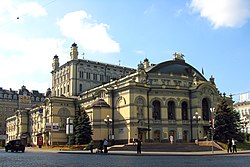Kiev Opera

Ukrainian National Opera House in Kiev.
|
|
| Address | vul. Volodymirska, 50 Kiev Ukraine |
|---|---|
| Coordinates | 50°26′48″N 30°30′45″E / 50.446667°N 30.5125°E |
| Capacity | 1683 |
| Construction | |
| Opened | 1901-09-29 |
| Architect | Victor Schröter |
| Website | |
| Official website | |
The Kiev Opera group was formally established in the summer of 1867, and is the third oldest in Ukraine, after Odessa Opera and Lviv Opera. Today, the Kiev Opera Company performs at the National Opera House of Ukraine named after Taras Shevchenko in Kiev.
Established in the summer of 1867 by Ferdinand Berger (? - 1875). Berger succeeded in inviting many talented singers, musicians, and conductors, and the city council (duma) had offered the newly created trouppe to use the City Theatre (constructed in 1856, architect I. Shtrom) for their performances. Officially, the theatre was named the City Theatre but was most commonly referred to as the Russian Opera. The day of the first performance, November 8 (October 27 old style), 1867 was made a city holiday. The performance of the opera Askold's Tomb by Alexey Verstovsky was the troupe's debut. The initial success is attributed to the vocal talents of that time of O. Satagano-Gorchakova, F. L'vov, M. Agramov but also to the captivating plot taken from some principal pages of the ancient history of the city.
Early performances were mostly Russian operas, including Ruslan and Ludmila by Mikhail Glinka, Rusalka by Alexander Dargomyzhsky, Maccabees by Anton Rubinstein and The Power of the Fiend by A. Serov, as well as translated European operas including The Barber of Seville by Rossini, The Marriage of Figaro by Mozart, Der Freischütz by Weber, Lucia di Lammermoor by Donizetti, and operas by Giuseppe Verdi, which became the favorite of the Kievites.
On February 4, 1896, after a morning performance of Eugene Onegin by Tchaikovsky, a fire erupted from an unextinguished candle in the theatre. The fire consumed the whole building within several hours. One of the largest musical libraries in Europe along with numerous costumes and stage props of many performances were lost during the fire. After the fire of the City Theatre, the troupe performed on other stages for several years, including Bergonie's Theatre (now the National Theatre of Russian Drama named after Lesya Ukrainka), Solovtsov's Theatre (now the National Theatre named after Ivan Franko) and even on the arena of the famous Krutikov's Circus.
...
Wikipedia
